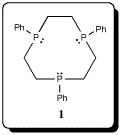
ACS PRF | ACS
All e-Annual Reports

42268-GB3
Synthesis and Metal Coordination Studies of New Triphosphacrowns with Group 10 Metals
| In the course of our investigations we have made numerous advances in the synthesis of the triphosphacrown family of ligands. The first synthetic step proposed in the synthesis of the 9P3 triphosphacrown (1) was formation of a reactive phosphide di-anion (Figure 1). This synthesis was completed in the first year of funding on this project and a report of the synthesis of this phosphide di-anion is currently in publication. |
| |
Reactions of the phosphorus dianion with 1,2-dichloroethane have been explored and yielded interesting results. Phosphorus-31 NMR data has indicated formation of closed ring products, however, isolation and purification of the reaction products have proven elusive. Mass spectral data and size-exclusion chromatography have shown that a mixture of products has been formed. Among the products tentatively identified are the 9P3 ring (Figure 2) and the 18P6 ring (Figure 3). | |
| |
| |
Work in our labs during the summer of 2007 have yielded insights into how temperature and reactant concentration affects the distribution of reaction products. With high-concentration, room temperature reactions, the 18P6 forms preferentially. However, upon high-dilution, high temperature reactions, the 9P3 ring forms almost exclusively. The two geometric isomers of the 9P3 ring have been clearly identified in the P-31 NMR of these reactions mixtures. Although it appears the 9P3 ring forms in good yield, isolation and purification of the 9P3 has, to date, been elusive. Preliminary metal coordination studies of the impure 9P3 reaction mixture have been carried out and look promising. When reacted with Mo(cht)(CO)3 (cht = cycloheptatriene) a single metal coordination product is formed, however, isolation and purification of this metal-compound has also remained elusive. | |
In an attempt to better understand the formation of the ring compounds and their metal complex, our lab also pursued formation of the smaller member of this family, the 6P2 ligand (shown in Figure 4). The synthesis of the ligand had been reported previously, however, very little work had been done on the metal coordination of this novel ligand. Our lab successfully synthesized three new rhodium(III) and iridium(III) complexes with this ligand (Figure 4). Interestingly, the iridium dimmer (shown in Figure 4) could not be converted into the analogous monomer complex seen with rhodium(III). A report of their synthesis and crystal structures is currently under preparation and will be appearing in the literature in 2008. | |
| |
The results obtained through funding of this grant have yielded excellent results with respect towards development of the crown phosphine family. Funding to continue this work will be pursued with the primary focus revolving around isolation and purification of the 9P3 ring compound and its metal complexes. Additionally, our lab intends to pursue formation of other metal complexes with the 6P2 ligand in an attempt to discover novel catalytic activity. | |




